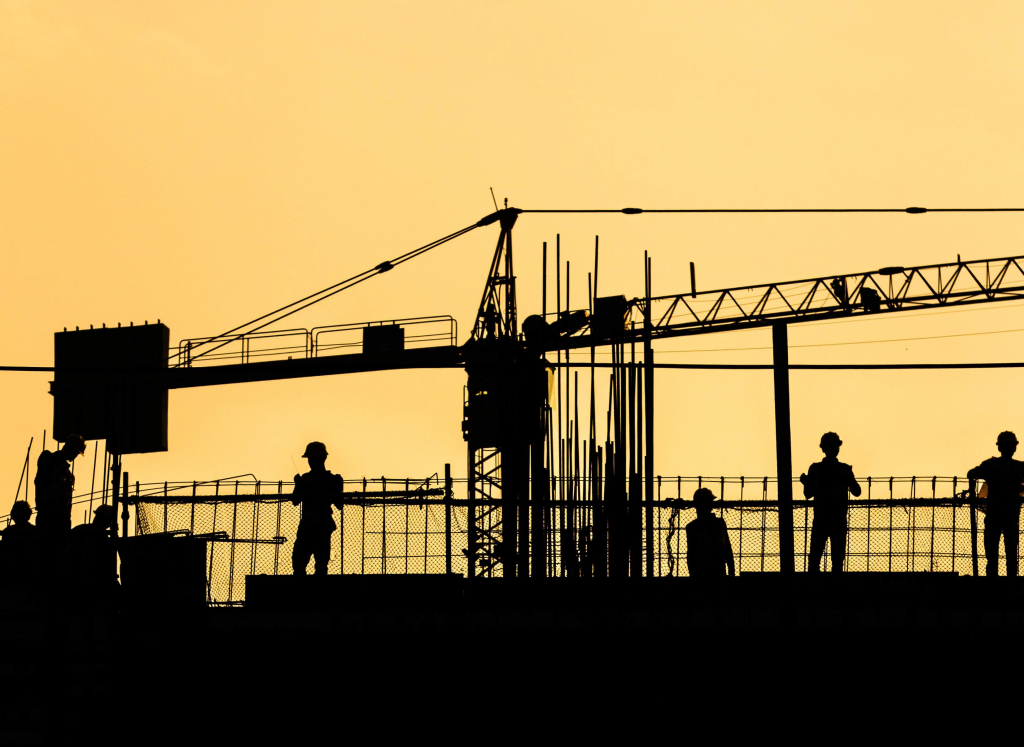Construction is the process of building structures like homes, offices, and roads. It’s a crucial part of everyday life because it helps create the spaces where people live, work, and travel. Without construction, we wouldn’t have the schools we attend, the parks we play in, or the hospitals that take care of us.
Construction involves many steps and requires a lot of teamwork. From architects who design the buildings to engineers who ensure everything is safe, and workers who actually build the structures, every person has an important role. Understanding construction helps us appreciate the effort that goes into making the world around us.
This guide will walk you through the different types of construction, the materials used, the technology that makes building easier, and the safety measures that protect workers. Whether you’re curious about how your house was built or thinking about a career in construction, this guide will give you a solid start.
Types of Construction Projects
Residential Construction
Residential construction involves building homes and apartments where people live. This type of construction can range from small single-family houses to large apartment complexes. Builders and architects work together to design and create spaces that are not only functional but also comfortable and attractive for people to live in.
Each residential project starts with a design that matches the needs of the family or individuals who will live there. Builders then use materials like wood, brick, and concrete to construct the house. Residential construction also includes renovations and repairs to existing homes to keep them safe and modern.
Commercial Construction
Commercial construction focuses on building structures used for business purposes. This includes office buildings, shopping malls, restaurants, and hotels. Unlike residential buildings, commercial projects often have to meet specific requirements for space, accessibility, and safety to serve their purpose efficiently.
Commercial construction projects usually involve larger teams and more complex designs compared to residential buildings. These projects need careful planning and coordination to ensure they meet the needs of businesses and comply with local regulations. Builders use a variety of materials and techniques to create spaces that are functional and appealing for commercial use.
Industrial Construction
Industrial construction involves building facilities for manufacturing and processing industries. This includes factories, warehouses, and power plants. Industrial buildings often have specialized designs to support heavy machinery and equipment used in production processes.
Industrial construction projects require detailed planning and engineering to ensure they can handle the specific needs of industries. Safety is a major concern due to the large machinery and materials involved. Builders need to make sure that these facilities are durable and can withstand the demands of industrial operations.
Infrastructure Projects
Infrastructure construction deals with building and maintaining public works like roads, bridges, and airports. These projects are essential for transportation and connectivity, making it easier for people and goods to move from one place to another.
Infrastructure projects often involve large-scale construction and require careful planning to minimize disruptions. Engineers and construction workers must ensure that these structures are safe and can support heavy traffic. Infrastructure projects are crucial for the development and growth of communities and economies.
Key Phases of a Construction Project
Planning and Design
The first phase of any construction project is planning and design. Architects and engineers work together to create detailed blueprints and plans for the building. This phase involves deciding on the layout, materials, and features of the structure.
During planning, various factors are considered, including the purpose of the building, local building codes, and the budget. Detailed drawings and specifications are made to guide the construction process. This phase is crucial for ensuring that the final building meets all requirements and expectations.
Site Preparation
Site preparation involves getting the construction site ready for building. This includes clearing the land, leveling the ground, and setting up utilities like water and electricity. Workers might also dig foundations and set up temporary structures for the construction process.
Proper site preparation is essential for a successful construction project. It ensures that the land is suitable for building and that any potential problems are addressed before construction begins. This phase helps prevent issues that could arise later in the project.
Construction
The construction phase is where the actual building takes place. Workers follow the plans and blueprints created during the design phase to build the structure. This involves tasks like laying foundations, erecting walls, and installing roofs.
During construction, teams of builders, electricians, plumbers, and other specialists work together to complete the project. Regular inspections are conducted to ensure that the work meets quality and safety standards. This phase is where the building starts to take shape and become functional.
Finishing and Inspection
The final phase of a construction project is finishing and inspection. This includes completing any remaining work, such as painting, installing fixtures, and landscaping. After the building is finished, it undergoes a thorough inspection to ensure everything is done correctly and meets building codes.
Inspections check for things like safety features, proper installation of systems, and overall quality. Any issues found during the inspection are corrected before the building is officially completed. This phase ensures that the building is ready for use and is safe for occupants.
Common Construction Materials
Concrete
Concrete is one of the most commonly used construction materials. It is made from a mixture of cement, water, and aggregates like sand and gravel. Concrete is strong, durable, and versatile, making it ideal for foundations, walls, and pavements.
Concrete is used in many types of construction, from residential homes to large commercial buildings and infrastructure projects. It can be poured into molds to create different shapes and sizes, making it a flexible material for various construction needs.
Wood
Wood is a traditional construction material used for building homes and other structures. It is valued for its natural beauty and strength. Wood is used for framing, flooring, and finishing touches like cabinets and trim.
Wood can be treated and finished in various ways to enhance its durability and appearance. It is often chosen for its aesthetic appeal and ease of use. However, wood construction requires careful maintenance to prevent issues like rot and pest damage.
Steel
Steel is a strong and durable material used in many modern construction projects. It is commonly used for structural frameworks, such as beams and columns, in large buildings and bridges. Steel’s strength allows for taller and more complex structures.
Steel is also used in commercial and industrial construction for its ability to support heavy loads and withstand various stresses. It is often chosen for its flexibility in design and its resistance to factors like fire and weather.
Masonry
Masonry involves using materials like bricks, stones, and blocks to build structures. This technique has been used for thousands of years and is known for its durability and strength. Masonry is often used for walls, facades, and other load-bearing parts of a building.
Masonry can create visually appealing and long-lasting structures. Different types of masonry materials can be used to achieve various styles and finishes. This technique is valued for its ability to create solid and attractive buildings.
Role of Technology in Modern Construction
Building Information Modeling (BIM)
Building Information Modeling (BIM) is a technology that helps in designing and managing construction projects. BIM uses digital models to create detailed 3D representations of buildings. This helps architects, engineers, and builders visualize the project before construction begins.
BIM allows for better planning and coordination among different teams. It helps identify potential issues early on and improve accuracy in construction. By using BIM, construction projects can be completed more efficiently and with fewer mistakes.
Drones and Robotics
Drones and robotics are changing the way construction projects are managed and executed. Drones are used for surveying sites, capturing aerial images, and monitoring progress. They provide valuable data and insights that help in planning and managing construction projects.
Robotics, such as automated machinery and robotic arms, are used to perform tasks like bricklaying and welding. These technologies increase precision and speed in construction. They also help improve safety by taking over dangerous tasks from human workers.
Sustainable Construction Practices
Sustainable construction practices focus on reducing the environmental impact of building projects. This includes using eco-friendly materials, energy-efficient designs, and practices that minimize waste. Sustainable construction aims to create buildings that are not only functional but also environmentally responsible.
Techniques like using recycled materials, implementing energy-saving technologies, and designing buildings to reduce energy consumption are part of sustainable construction. These practices help protect natural resources and create healthier environments for people.
Safety in Construction
Importance of Safety Protocols
Safety protocols in construction are crucial to protect workers from accidents and injuries. Construction sites can be dangerous, with risks like falling from heights, heavy machinery, and hazardous materials. Following safety protocols helps minimize these risks and keep everyone on the site safe.
Safety protocols include things like proper training, regular inspections, and clear safety guidelines. Workers must use safety equipment and follow procedures to avoid accidents. Emphasizing safety helps create a safer work environment and ensures that construction projects are completed without harm.
Common Safety Practices
Common safety practices on construction sites include wearing personal protective equipment (PPE) such as helmets, gloves, and safety glasses. Workers should also be trained in safe work practices, like proper lifting techniques and safe operation of machinery.
Other safety practices include setting up barriers and signs to warn of hazards, maintaining clean and organized work areas, and ensuring that emergency procedures are in place. Regular safety meetings and drills help keep safety awareness high and prepare workers for potential emergencies.
Personal Protective Equipment (PPE)
Personal protective equipment (PPE) is essential for protecting construction workers from injuries. PPE includes items like helmets, safety goggles, gloves, and steel-toed boots. Each piece of equipment is designed to protect against specific hazards on the construction site.
For example, helmets protect against falling objects, while safety goggles shield eyes from dust and debris. Gloves help prevent hand injuries, and steel-toed boots protect feet from heavy items. Wearing the right PPE helps reduce the risk of injuries and ensures that workers are safe on the job.
Career Opportunities in Construction
Skilled Trades
Skilled trades involve hands-on work in areas like plumbing, electrical work, and carpentry. These trades require specialized training and skills. Skilled tradespeople are essential in construction,
Conclusion
Construction is a vital field that shapes the environment we live in, from our homes and workplaces to the roads and bridges that connect us. Understanding the different types of construction projects, the materials used, and the technology involved provides a deeper appreciation for the work that goes into building our world.



